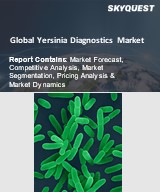
Report ID: SQMIG35A2897

Report ID:
SQMIG35A2897 |
Region:
Global |
Published Date: May, 2024
Pages:
219
|
Tables:
70 |
Figures:
70
Drivers
Prevalence of Yersinia Infections:
Yersinia species, particularly Yersinia enterocolitica and Yersinia pseudotuberculosis, are significant causes of foodborne illness and gastrointestinal infections worldwide. The prevalence of Yersinia infections varies geographically and temporally, but regions with a higher incidence of these infections create a substantial demand for diagnostic tests. As the number of cases increases, healthcare providers and public health authorities require accurate diagnostic tools to identify and manage Yersinia infections effectively.
Increasing Incidence of Foodborne Illnesses:
Yersinia species are commonly transmitted through contaminated food and water. With growing global populations, changes in food production and distribution, and shifts in dietary habits, the incidence of foodborne illnesses caused by Yersinia is on the rise. This trend underscores the need for reliable diagnostic tests that can quickly identify Yersinia contamination in food and detect infections in individuals presenting with symptoms of foodborne illness. Diagnostic companies respond to this demand by developing and commercializing innovative testing solutions tailored to food safety and clinical diagnosis.
Advancements in Diagnostic Technologies
Technological advancements drive innovation in diagnostic platforms and methodologies, leading to improvements in sensitivity, specificity, and turnaround time for Yersinia diagnostics. Molecular methods such as polymerase chain reaction (PCR) and nucleic acid amplification tests (NAATs) offer high sensitivity and specificity for detecting Yersinia DNA in clinical specimens and food samples. Immunoassays, including enzyme-linked immunosorbent assays (ELISAs), detect Yersinia-specific antibodies or antigens in patient samples. Point-of-care testing (POCT) devices provide rapid and user-friendly options for diagnosing Yersinia infections in various healthcare settings, from clinics to remote locations.
Restraints
Complexity of Yersinia Infections
Yersinia infections can manifest with a wide range of symptoms, including gastrointestinal symptoms such as diarrhoea, abdominal pain, and fever. However, these symptoms are nonspecific and can overlap with other gastrointestinal infections, making clinical diagnosis challenging. Additionally, Yersinia infections can mimic other conditions such as appendicitis, leading to misdiagnosis or delayed diagnosis. The complexity of Yersinia infections and the lack of specific clinical features can hinder the accurate and timely identification of cases, impacting the demand for Yersinia diagnostics tests.
Variability in Yersinia Strains
Yersinia species encompass multiple strains and serotypes, each with distinct virulence factors and pathogenicity profiles. Yersinia enterocolitica, for example, comprises various biotypes and serotypes, each associated with different clinical manifestations and disease severity. The genetic diversity and antigenic variability of Yersinia strains pose challenges for diagnostic test development and validation. Diagnostic assays must demonstrate robust performance across diverse strains to ensure accurate detection and differentiation of Yersinia infections. However, strain-specific differences in antigenicity and genetic markers may affect the sensitivity and specificity of diagnostic tests, limiting their utility in detecting all Yersinia variants.
Limitations of Traditional Culture-based Methods
Traditional culture-based methods, such as stool culture for Yersinia species isolation, remain the gold standard for laboratory diagnosis. However, these methods have several limitations, including lengthy turnaround times, low sensitivity, and dependence on specialized laboratory infrastructure and expertise. Culturing Yersinia species can be challenging due to their slow growth, fastidious nutritional requirements, and the presence of competing microorganisms in clinical specimens. As a result, culture-based methods may fail to detect low-level Yersinia infections or strains with atypical growth characteristics, leading to false-negative results and diagnostic delays.
Our industry expert will work with you to provide you with customized data in a short amount of time.
REQUEST FREE CUSTOMIZATIONWant to customize this report? This report can be personalized according to your needs. Our analysts and industry experts will work directly with you to understand your requirements and provide you with customized data in a short amount of time. We offer $1000 worth of FREE customization at the time of purchase.

Report ID: SQMIG35A2897